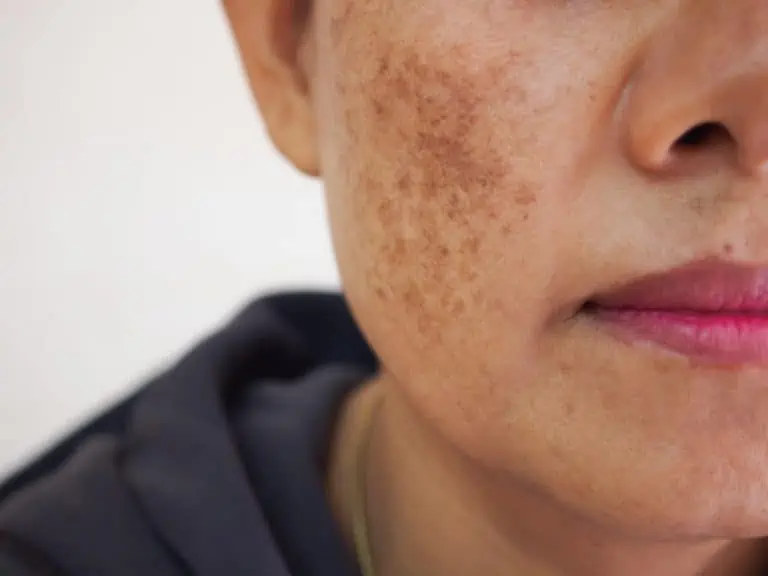Melasma Treatment: How to Fade These Brown Patches on the Skin

Melasma causes brown patches on the skin that many people find unsightly or embarrassing. It’s sometimes called “the mask of pregnancy,” but the condition isn’t limited to pregnant women. What triggers these dark splotches? And if you have them, what’s the best melasma treatment?
Read on to discover answers. There is no surefire melasma cure, and the condition can be difficult to treat without making it worse — a good reason to see a dermatologist or other qualified skin care provider rather than randomly picking an over-the-counter melasma cream. An experienced provider will help you zero in on treatments that offer the best possible chance at giving you back a more even complexion.
What is melasma?
Melasma is a type of hyperpigmentation, a condition in which cells that produce the skin pigment melanin make too much of it. In melasma, this results in dark patches. The patches are usually brown, but they may be blue-gray or gray-brown in people with darker skin. They usually appear on the face — the cheeks, the bridge of the nose, the upper lip or the chin. Patches on the upper lip are sometimes called a melasma mustache or a sunstache.
Occasionally, melasma appears on other parts of the body that get a lot of sun exposure, including the forearms, shoulders and neck.
Anyone can develop melasma, but 90% of cases happen in women. The condition is more likely if your skin tone is medium or dark. It typically appears in a person’s 20s, 30s or 40s.
For the best results, seek treatment ASAP. It’s harder to fade melasma patches if you’ve had them for years.
Melasma vs. sun spots
Brown patches on the face are sometimes mistaken for age spots, also known as sun spots or liver spots, but these two hyperpigmentation conditions are different.
Age spots are caused by years of sun damage. They are isolated small or large spots and are closer to the surface of the skin than melasma patches, which makes them easier to treat. They can appear on any body part that gets sun exposure, such as the hands.
Melasma, on the other hand, causes dark patches that most often appear on the face, usually on both sides. Sun exposure is just one of several possible triggers. Unlike age spots, melasma patches sometimes disappear on their own.
Melasma causes
Melasma causes aren’t well understood. The condition likely results from some combination of genes (up to half of people with melasma have or had a close relative with melasma), hormonal changes and sun exposure. In some cases, a medication is to blame.
Here are some common melasma triggers.
Pregnancy, birth control and HRT
As many as half of pregnant women develop melasma. The surges of estrogen and progesterone that occur during pregnancy are thought to send the cells that produce melanin, called melanocytes, into overdrive.
Starting or stopping hormonal forms of birth control or undergoing hormone replacement therapy can also trigger melasma.
Cortisol, the “stress hormone”
Experts are divided on whether stress triggers melasma. Some studies suggest a connection. If there is one, fluctuating levels of cortisol could be to blame, since cortisol plays a major role in the body’s response to stress.
Sunlight
Exposure to ultraviolet (UV) light causes melanocytes to produce more melanin. It’s possible that melasma could result from uneven melanin production after sun exposure or tanning bed use.
Thyroid disease
Melasma is more common in people with hypothyroidism, a condition in which the thyroid gland doesn’t make enough thyroid hormone. More research is needed to determine whether there’s a direct relationship.
Medication
Some medications have been associated with melasma. They include certain:
- Anti-seizure medications
- Non-steroidal anti-inflammatory drugs (NSAIDs)
- Drugs that make you more sensitive to the sun, some blood pressure pills and some antibiotics
Sun exposure can intensify melasma that’s triggered by medications. Switching medications or reducing the dosage, if your doctor okays it, may improve it.
Skin irritants
Skin irritants can cause melasma or make it worse by causing inflammation that leads to increased pigment production. Potential irritants include makeup, harsh or scented soaps and even some skin treatments.
Melasma treatment
Melasma is difficult to treat. The patches sometimes go away, or at least fade, on their own. That’s more likely to happen if they developed during pregnancy or after starting birth control pills. For many people, however, the condition is chronic. Even if you treat it successfully, the patches may come back.
For the best results, seek treatment ASAP. It’s harder to fade melasma patches if you’ve had them for years. Before suggesting treatment options, your dermatologist will confirm that the brown patches on your face are in fact melasma and not another skin condition.
There is no one melasma treatment that works for everyone. Your dermatologist will likely recommend a combination of treatments as part of a custom management plan that’s based on your skin type, your melasma triggers and the depth of your skin patches. Avoiding sun exposure is critical.
Hydroquinone
Hydroquinone, a topical skin-lightening medication, is one of the most common treatments for melasma. Over-the-counter 2% hydroquinone products are available, as are stronger prescription versions. However, hydroquinone can’t be used long term because it may eventually cause a bluish discoloration of the skin called ochronosis.
Hydroquinone is often prescribed together with tretinoin (Retin-A) and a mild corticosteroid. The combination works better than hydroquinone alone. It’s available as a melasma cream that’s sometimes referred to as triple treatment cream.
Tretinoin plus a steroid
If you have dark skin, your doctor might prescribe topical tretinoin and a topical steroid, leaving out the hydroquinone.
Tranexamic acid
Extremely stubborn melasma may respond to skin-brightening tranexamic acid, which is available in topical and oral forms.
Vitamin C and other acids
Gentler topicals that may be used to fade melasma patches include vitamin C (ascorbic acid), azelaic acid and kojic acid.
In-office procedures
If other treatments deliver so-so results, your dermatologist may suggest adding one of several in-office treatments to remove excess pigment and/or increase skin cell turnover. Options include microneedling, a chemical peel or a laser treatment.
If you go the chemical peel or laser route, it’s important to see a board-certified dermatologist or a licensed aesthetician who has experience treating melasma. Peels that use strong acids can cause more brown patches, as can some laser therapies.
The one thing everyone with melasma should do is apply sunscreen liberally. Use a broad-spectrum sunscreen with an SPF of at least 30. Many dermatologists recommend choosing a mineral sunscreen rather than a chemical sunscreen. Try a tinted mineral sunscreen. The iron oxide helps to block blue light from cell phone and computer screens, which could contribute to skin discoloration.
Book a consultation today to get your melasma treatment started.
Medically reviewed by Jeriel Weitz, DO
Written by Jessica Brown, a health and science writer/editor based in Nanuet, New York. She has written for Water’s Edge Dermatology, Prevention magazine, jnj.com, BCRF.org, and many other outlets.


